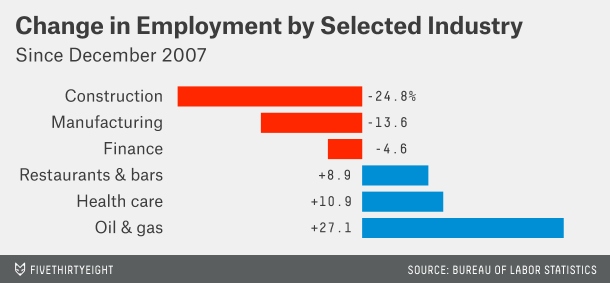While this week’s report shows continued improvement in the job’s data, the types of jobs that people are securing is changing. In May, the U.S. finally recovered all the jobs that were lost since the recession that commenced in late 2007. May concluded the first consecutive four-month stretch since the late 1990s in which job creation surpassed 200,000, according to the Labor Department’s latest report. In fact, U.S. payrolls in May hit an all-time high. In sum, employers added 217,000 jobs last month. The unemployment rate was unchanged at 6.3%.
While the number of those working is at record levels, the quality of jobs and the associated pay have both declined. Since 2008, the number of jobs in such typically well-paying job fields as construction, manufacturing and government has declined. While the number of U.S. manufacturing jobs has fallen by 1.6 million since the recession started, the accommodation and food service sector has seen a 941,000 increase in jobs. Over the last year, more than 40% of jobs added have come in lower-paying fields such as food service, retail and temporary help.
The implication is that U.S. jobs are becoming increasingly concentrated at the high and low ends. In its May Economic Letter, the Dallas Federal Reserve Bank discussed this phenomenon in more detail. The paper concluded that the number of medium skill level jobs has narrowed. At the same time, the number at both ends of the distribution – those requiring high and low skill levels – has widened. They attributed the change to “increased automation of routine tasks, a relative scarcity of skilled workers and to a lesser extent, relocation of jobs outside the country.” These factors have contributed to an increase in the number of people performing low-pay manual labor tasks. At the same time, more individuals are performing high-skill, high-pay, non-routine, jobs that are largely aimed at problem solving.
This polarization of the work force began about 25 years ago. It has intensified over the last decade. The most common explanation given for these changes is the automation of routine tasks. Computing power has increased while the cost of providing it has fallen sharply. As a result, computers have replaced a large number of workers performing routine tasks. Another contributing factor has been the relative ease of offshoring jobs due to increased globalization. In short, if a worker in a developed country is replaced by either a computer or an employee in a less-developed economy, the number of middle-skill jobs falls. The rate at which the labor market polarizes is unlikely to decelerate in the near future.
The changing workforce also materially impacts retail sales activity. Against this backdrop, we have tended to avoid those retail businesses that rely most heavily on the middle class consumer. Instead, when selecting consumer discretionary stocks for client portfolios we have tended to focus on those businesses frequented by the high- and low-end consumers.



